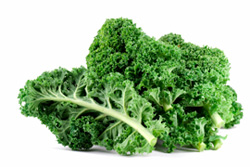Eating with a Conscience
Choosing organic food to protect health and the environment
View a different non-organic crop
 Collard Greens/Kale
Collard Greens/Kale
Below are the pesticides with established tolerances (residue limits for pesticides used in the U.S. or by countries exporting to the U.S.) for collard greens/kale. While not all the pesticides on the list are applied to all collard greens/kale, there is no way to tell which pesticides are applied to any given piece of conventional produce on your store shelf. You may consider talking to the farmers at your local farmers market about the pesticides they use, but eating organic is the only way to know for sure.
California Farmworker Poisonings, 1992–2010: Not a major California crop.
Pesticide Tolerances —Health and Environmental Effects: The database shows that while collard greens/kale grown with toxic chemicals show low pesticide residues on the finished commodity, there are 33 pesticides with established tolerance for collard greens/kale, 11 are acutely toxic creating a hazardous environment for farmworkers, 29 are linked to chronic health problems (such as cancer), 9 contaminate streams or groundwater, and 27 are poisonous to wildlife.
![]() Pollinator Impacts: In addition to habitat loss due to the expansion of agricultural and urban areas, the database shows that there are 15 pesticides used on collard greens/kale that are considered toxic to honey bees and other insect pollinators. For more information on how to protect pollinators from pesticides, see Beyond Pesticides' BEE Protective webpage.
Pollinator Impacts: In addition to habitat loss due to the expansion of agricultural and urban areas, the database shows that there are 15 pesticides used on collard greens/kale that are considered toxic to honey bees and other insect pollinators. For more information on how to protect pollinators from pesticides, see Beyond Pesticides' BEE Protective webpage.
- This crop is NOT dependent on pollinators.
- This crop is foraged by pollinators.

(A = acute health effects, C = chronic health effects, SW = surface water contaminant, GW = ground water contaminant, W = wildlife poison, B = bee poison, LT = long-range transport)
|
Azoxystrobin Bifenthrin Boscalid Chlorantraniliprole Chloroneb Clethodim Cryolite Cyfluthrin Cypermethrin | Cyprodinil Dimethoate Dimethomorph Endosulfan Fenamidone Flonicamid Flubendiamide Fludioxonil Mandipropamid | Maneb Methomyl Methoxyfenozide Naled Pymetrozine Pyraclostrobin Pyriproxyfen Spinetoram Spinosad | Spiromesifen Spirotetramat Tebuconazole Tebufenozide Thiamethoxam Triflumizole |
All tolerance data is based on the Environmental Protection Agency's Tolerances and Exemptions for Pesticide Chemical Residues in Food located in the Electronic Code of Federal Regulations (eCFR). For more information, see our Methodology page.








